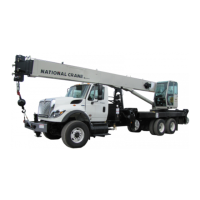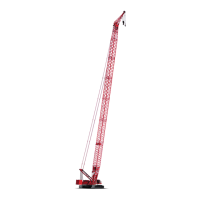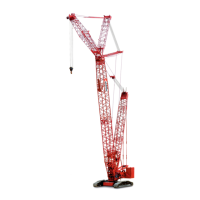INTRODUCTION 14000 SERVICE MANUAL
1-2
Published 09-10-14, Control # 065-24
and Service Manual before attempting any maintenance
procedure. If there is any question regarding maintenance
procedures or specifications, contact your Manitowoc dealer
for assistance.
Training/qualification of maintenance personnel is
responsibility of the crane owner.
Safe Maintenance Practices
1. Perform the following steps (as applicable) before
starting a maintenance procedure:
a. Park the crane where it will not interfere with other
equipment or operations.
b. Lower all loads to the ground or otherwise secure
them against movement.
c. Lower the boom onto blocking at ground level, if
possible, or otherwise secure the boom against
dropping.
d. Move all controls to off and secure all functions
against movement by applying or engaging all
brakes, pawls, or other locking devices.
e. Stop the engine and render starting means
inoperative.
f. Place a warning sign at start controls alerting other
personnel that the crane is being serviced and the
engine must not be started. Do not remove sign until
it is safe to return the crane to service.
2. Do not attempt to maintain or repair any part of the crane
while the engine is running, unless absolutely
necessary.
If the engine must be run, keep your clothing and all
parts of your body away from moving parts. Maintain
constant verbal communication between person at
controls and person performing maintenance or
repair procedure.
3. Wear clothing that is relatively tight and belted.
4. Wear appropriate eye protection and approved hard hat.
5. Never climb onto or off a moving crane. Climb onto and
off the crane only when it is parked and only with
operator’s permission.
Use both hands and handrails, steps and ladders
provided to climb onto and off the crane.
Lift tools and other equipment which cannot be carried in
pockets or tool belts onto and off the crane with hand
lines or hoists.
6. Boom and gantry are not intended as ladders. Do not
attempt to climb lattice work of the boom or gantry to get
to maintenance points. If the boom or gantry is not
equipped with an approved ladder, lower them before
performing maintenance or repair procedures.
7. Do not remove cylinders until working unit has been
securely restrained against movement.
8. Pinch points are impossible to eliminate; watch for them
closely.
9. Pressurized air, coolant, and hydraulic oil can cause
serious injury. Make sure all air, coolant, and hydraulic
lines, fittings, and components are tight and serviceable.
Do not use your hands to check for air and hydraulic
oil leaks:
• Use a soap and water solution to check for air leaks
(apply to fittings and lines and watch for bubbles).
• Use a piece of cardboard or wood to check for
coolant and hydraulic oil leaks.
10. Relieve pressure before disconnecting air, coolant, and
hydraulic lines and fittings.
11. Do not remove radiator cap while coolant is hot or under
pressure. Stop the engine, wait until pressure drops and
coolant cools, then slowly remove cap.
12. Avoid battery explosion: do not smoke while performing
battery maintenance, do not short across battery
terminals to check its charge.
13. Read safety information in battery manufacturer’s
instructions before attempting to charge a battery.
14. Avoid battery acid contact with skin and eyes. If contact
occurs, flush area with water and immediately consult a
doctor.
15. Stop the engine before refueling the crane.
16. Do not smoke or allow open flames in refueling area.
17. Use a safety-type can with an automatic closing cap and
flame arrestor for refueling.
18. Hydraulic oil can also be flammable. Do not s
moke or
allow open flames in area when filling hydraulic tanks.
19. Never handle wire rope with bare hands. Always wear
heavy-duty gloves to prevent being cut by broken wires.
20. Use extreme care when handling coiled pendants.
Stored energy can cause coiled pendants to uncoil
quickly with considerable force.
21. When inflating tires, use a tire cage, a clip-on inflator,
and an extension hose which permits standing well away
from tire.
22. Only use cleaning solvents which are non-volatile and
non-flammable.
23. Do not attempt to lift heavy components by hand. Use a
hoist, jacks, or blocking to lift components.

